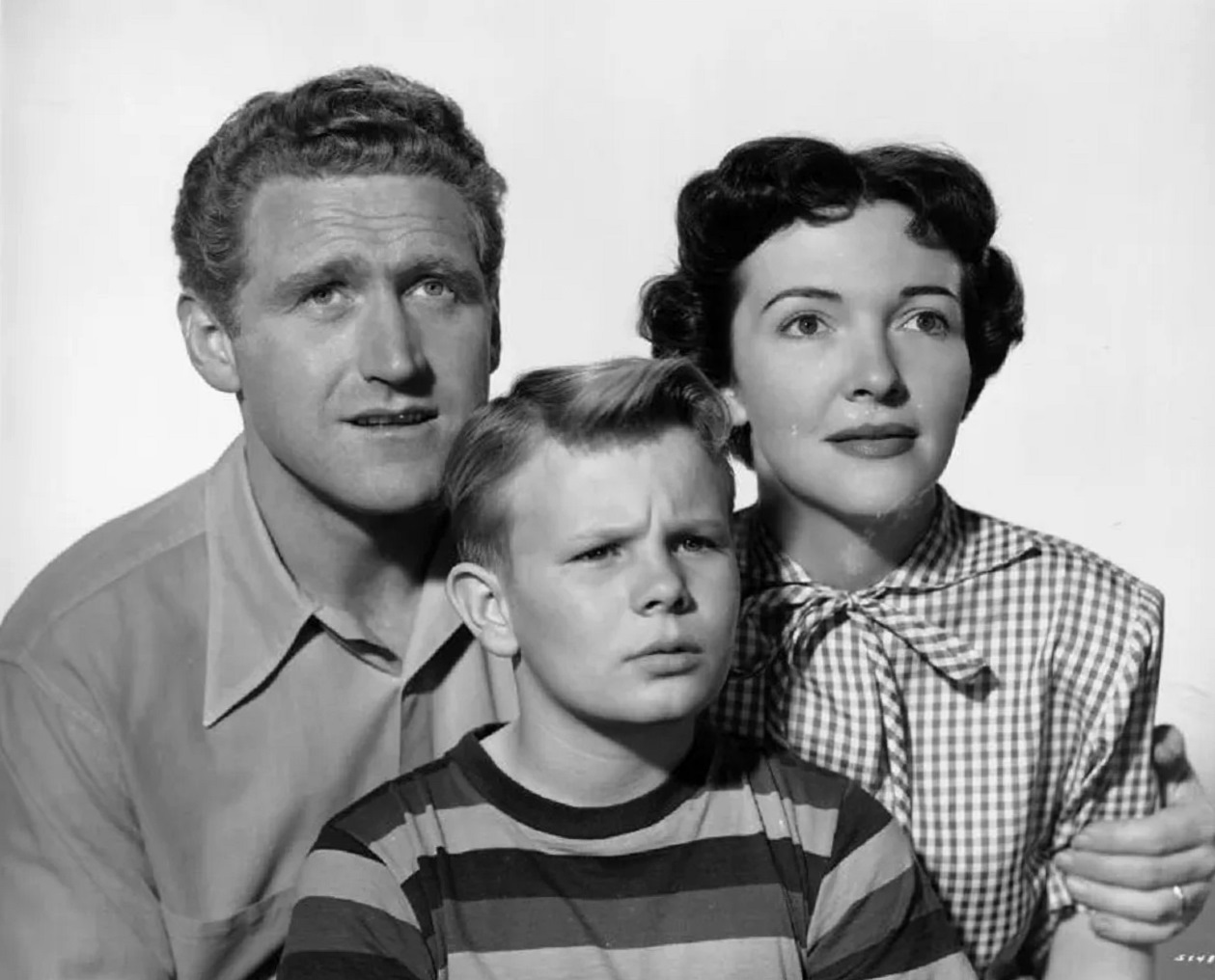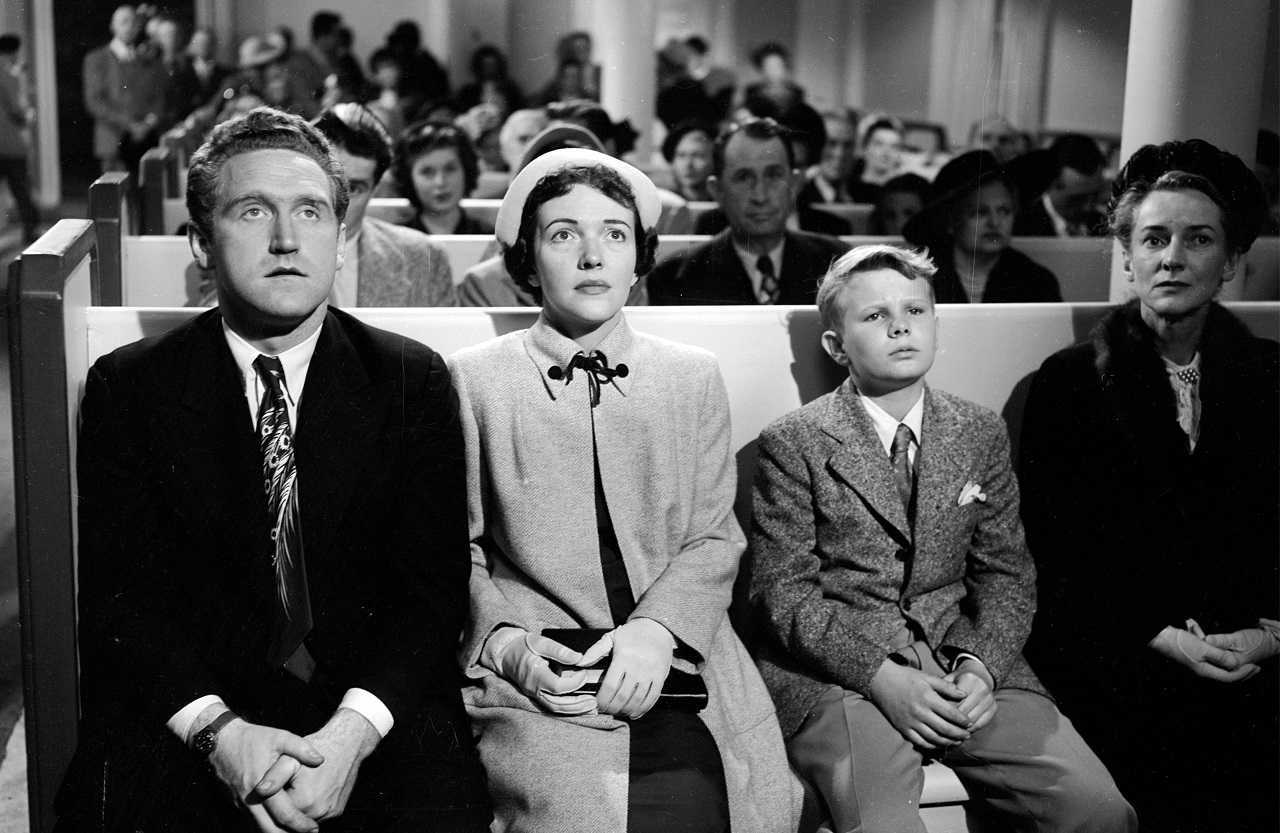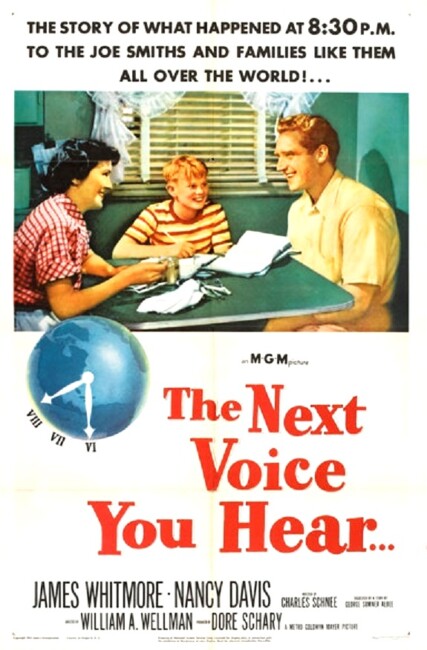USA. 1950.
Crew
Director – William A. Wellman, Screenplay – Charles Schnee, Suggested by a Story by George Sumner Albee, Producer – Dore Schary, Photography (b&w) – William Mellor, Music – David Raksin, Art Direction – Cedric Gibbons & Eddie Imazu. Production Company – Lowe’s Incorporated.
Cast
James Whitmore (Joe Smith), Nancy Davis (Mary Smith), Gary Gray (Johnny Smith), Lillian Bronson (Aunt Ethel), Art Smith (Fred Brannan), Tom D’Andrea (Hap Magee), Jeff Corey (Freddie)
Plot
Joe Smith is an average guy living in Los Angeles, working for an airplane manufacturer, with a son Johnny and a wife Mary who is expecting a second child. Joe is startled one evening when a voice appears on the radio claiming to be God. The voice is heard all around the world – in all cases speaking in the language of the person listening. There is much debate about whether this is a hoax while the authorities admit to being baffled as to how it is perpetrated. As the voice continues to appear at 8:30 pm over the next few nights, it starts to have a strange effect on people.
The 1950s was a period of religious revivalism. Going by the cinema of the period at least, the era was fraught with fears about Communism and the atomic bomb. As a result, a massive surge of interest in faith began to sweep USA and the world – this was the peak years of revivalists like Billy Graham and Oral Roberts. It is always the period that people who talk about Family Values like to enshrine in nostalgia and think of as a time when tradition, the nuclear family, the suburban neighbourhood and post-War economy were at their height and the USA was a God-fearing nation.
Amid this, it is a not a surprise that we had a film like The Next Voice You Hear … and that it was given a release by a major studio MGM (although the studio’s logo and name do not appear on the credits). The film adapts a 1948 short story by George Sumner Albee that appeared in Cosmopolitan magazine. The film comes steeped in its patriotism – James Whitmore is billed on the opening credits not just as the character he plays but as ‘Mr Joe Smith, American’.
People today don’t really seem to get how central radio was to people’s lives in the 1940s and 50s. It is what television used to be (even though the model of what television used to be has now been superseded by streaming content) where the radio was the centrepiece of the home, bringing news, entertainment, sports and music and people would sit around it for an evening’s entertainment. Thus it is no particular surprise that when God chose to deliver his message to the people that He chose radio as the medium to do so as does here and in the subsequent SF film Red Planet Mars (1952), in which people receive messages from God on Mars. (See Religion in Fantastic Cinema).

The plot has to perform some strange contortions to avoid actually depicting the voice of God, having various dramas occur right at the moment each broadcast occurs so that James Whitmore is out of the room and then having what was said recounted to him by others afterwards. Although you do end up wondering how the Voice of God, which is supposedly heard simultaneously worldwide, manages to deal with time zones – does God simulcast when He speaks all around the world? If He broadcasts at 8:30 pm in Los Angeles, it would be 11:30 pm on the eastern seaboard of the US and 4:30 am in London, for instance.
I expected a preachy film but William A. Wellman, a solid dramatist with a long history (see below), does a not bad job. The plot takes a dogleg turn towards the end to have James Whitmore discover the temptations of drink and loose women before realising he has been led astray and is rebelling against the goodness in his life. The overall message isn’t so much that people need to go to church more, rather that people just need to slow down and take life more easily with respect for others.
There is an undeniable sense of humour to the film at times like the scenes where Jesse Whitmore does his kid’s paper round and has to deal with dogs and his grumpy boss (Art Smith); the encounter with a traffic cop; or of the kid mimicking the routine his father goes through starting the car and backing down the drive in the morning.

The interesting piece of casting the film has is Nancy Davis. Two years after the film was made, Nancy met Ronald Reagan, married him and quit acting to raise a family before becoming the First Lady of the US after Reagan became President in 1981. Nancy Davis Reagan only acted in a handful of roles and it is interesting to watch her here after having become used to seeing her as a public figure. Her one other genre role was as the wife in the disembodied brain film Donovan’s Brain (1953). In the role of the long-suffering wife here, she gives a passable performance.
Director William A. Wellman (1896-1975) had an interesting background. He flew planes for the French Foreign Legion during World War I and returned home to train US pilots, before being given a break in the film industry by Douglas Fairbanks. He became a director in the 1920s and made the flying film Wings (1927), which became the first ever film to win an Academy Award for Best Picture. Over the next three decades, Wellman directed classic films such as The Public Enemy (1931), So Big! (1937), the original A Star is Born (1937), Beau Geste (1939), The Ox-Bow Incident (1942), Buffalo Bill (1944) and the first ever disaster movie The High and the Mighty (1954) to name the most famous.
Trailer here


